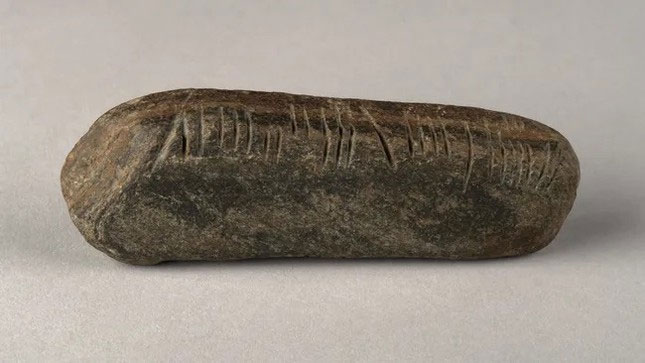The mystery of the stone engraved with a 1,600-year-old message
A man in England was weeding his garden when he accidentally discovered a stone engraved with a 1,600-year-old message. It is the rare Irish alphabet.
Investigations revealed that the stone was inscribed with an ogham message , an Irish alphabet used since the 4th century AD.
At first glance, the inscription looks like a series of vertical lines cut into a stone the size of a chocolate bar. But this is actually an ogham script , an alphabet used to write Early Irish from the 4th century and Old Irish from the 6th to 9th centuries . This discovery has puzzled archaeologists because they cannot explain how the stone with this ancient inscription came to be in the city of Coventry, central England.

The stone and ancient inscription in the ogham alphabet were found in a garden in the English city of Coventry. (Photo: Herbert Museum and Art Gallery).
It has been suggested that these may have been souvenirs, something carried by Irish Catholic monks on their mission to convert pagan Mercians in the area, or a way of introduction by Irish traders.
Teresa Gilmore, an archaeologist at the Birmingham Museums Foundation, UK, said: 'There are many possibilities as to why it appeared. This is one of the amazing discoveries."
Gilmore is the discovery liaison officer for the British Museum's Portable Antiquities Programme, which was awarded the stone in 2020.
Geography teacher Graham Senior, who found the stone while he was weeding his garden in Coventry during the COVID-19 lockdown in 2020, said: 'I noticed it. while clearing an overgrown part of the garden. At first, I thought it was some kind of calendar. Later I discovered it was an ogham stone and was over 1,600 years old, which was unbelievable."
Senior contacted the Portable Antiquities Programme, which records historical objects discovered in England and Wales.
Irish script
Gilmore's efforts were rewarded when photographs of the stone were seen by Glasgow University historian Katherine Forsyth, who confirmed the lines on it were an early ogham-style inscription.
Gilmore explains that the first part relates to a person's name - "Mael Dumcail" - but the meaning of the remaining part is unknown.
The object is made of sandstone . The engravings are cut into three angles between the sides of the stone. This was the popular writing style of the ogham script before the appearance of parchment and writing paper.
Ogham has some similarities with Norse runes , which also include straight lines. But ogham only uses parallel lines in groups and it seems to have been developed independently for writing in Irish. Ogham was replaced by Insular, a medieval alphabet once used throughout England, mainly for writing Latin.
This stone is a rare find. There are only about 400 known ogham inscriptions (compared to thousands of Norse runic inscriptions) and only 10 have been found in Britain.
- The mystery of the thousand-year-old stone jars contains remains of dead people in Laos
- Decode the mysterious message on a 1,500-year-old ancient slab
- Mysterious 230-year-old ancient stone in France
- Discovered the 4,000-year-old stone slabs carving Atum
- Compose a lie message that takes more time
- Discovered a 2,000-year-old iron pen engraved in English
- 2,500-year-old curse card in ancient well
- 900 years ago the Vikings wrote love letters
- 5,000-year-old giant wheel on the plateau
- The mystery of the statues that existed for 800 years made Chinese people fearful
- Strange statues of tens of tons?
- Reveal the mystery of traces on the
 Discovered an ancient centipede fossil 99 million years old
Discovered an ancient centipede fossil 99 million years old Discovered bat-like dinosaurs in China
Discovered bat-like dinosaurs in China Discovered a 200-year-old bronze cannon of the coast
Discovered a 200-year-old bronze cannon of the coast Discover 305 million-year-old spider fossils
Discover 305 million-year-old spider fossils